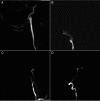Acute three-vessel cervical arterial occlusion due to spontaneous quadruple cervical artery dissection
- PMID: 24957585
- PMCID: PMC4069629
- DOI: 10.1136/bcr-2014-203725
Acute three-vessel cervical arterial occlusion due to spontaneous quadruple cervical artery dissection
Abstract
Cervical artery dissection (CAD) is one of the most frequent causes (14.5%) of stroke in young adults. Cases with involvement of more than two arteries are rare. Arnold et al described 11 cases (1.5%) with triple CAD of a reported 740 patients and just a single (0.1%) quadruple case in the same population. Simultaneous dissection of the four principal vessels is extremely rare. According to Papagiannaki et al, the incidence of simultaneous three or four CADs is 1-3/million in the general population. To the best of our knowledge, there are only three published cases of spontaneous quadruple CAD.
2014 BMJ Publishing Group Ltd.
Figures





Similar articles
-
Spontaneous dissection of bilateral internal carotid and vertebral arteries.BMJ Case Rep. 2021 Mar 29;14(3):e241173. doi: 10.1136/bcr-2020-241173. BMJ Case Rep. 2021. PMID: 33782071 Free PMC article. Review.
-
Intracranial dissection during carotid endarterectomy treated by carotid stenting.Vasa. 2009 Feb;38(1):81-4. doi: 10.1024/0301-1526.38.1.81. Vasa. 2009. PMID: 19229809
-
Stroke prevention by endovascular treatment of carotid and vertebral artery dissections.J Neurointerv Surg. 2017 Oct;9(10):952-957. doi: 10.1136/neurintsurg-2016-012565. Epub 2016 Sep 23. J Neurointerv Surg. 2017. PMID: 27663558
-
3D T1-weighted black blood sequence at 3.0 Tesla for the diagnosis of cervical artery dissection.Stroke Vasc Neurol. 2016 Oct 25;1(3):140-146. doi: 10.1136/svn-2016-000028. eCollection 2016 Sep. Stroke Vasc Neurol. 2016. PMID: 28959476 Free PMC article.
-
Ultrasound assessment of cervical artery dissection.Front Neurol Neurosci. 2005;20:87-101. doi: 10.1159/000088153. Front Neurol Neurosci. 2005. PMID: 17290115 Review.
Cited by
-
Case Report: De novo Vertebral Artery Dissection After Intravascular Stenting of the Contralateral Unruptured Vertebral Artery Aneurysm.Front Neurol. 2021 Apr 23;12:599197. doi: 10.3389/fneur.2021.599197. eCollection 2021. Front Neurol. 2021. PMID: 33967933 Free PMC article.
-
Association between Pregnancy and Cervical Artery Dissection.Ann Neurol. 2020 Sep;88(3):596-602. doi: 10.1002/ana.25813. Epub 2020 Jul 13. Ann Neurol. 2020. PMID: 32525238 Free PMC article.
-
Spontaneous dissection of bilateral internal carotid and vertebral arteries.BMJ Case Rep. 2021 Mar 29;14(3):e241173. doi: 10.1136/bcr-2020-241173. BMJ Case Rep. 2021. PMID: 33782071 Free PMC article. Review.
-
Facial twitching: calcium or concussion conundrum? Hypocalcaemia in a young American football player masking an internal carotid artery dissection.BMJ Case Rep. 2020 Apr 28;13(4):e231506. doi: 10.1136/bcr-2019-231506. BMJ Case Rep. 2020. PMID: 32350051 Free PMC article.
References
-
- Larrue V, Berhoune N, Massabuau P, et al. Etiologic investigation of ischemic stroke in young adults. Neurology 2011;76:1983–8 - PubMed
-
- Arnold M, De Marchis GM, Stapf C, et al. Triple and quadruple spontaneous cervical artery dissection: presenting characteristics and long-term outcome. J Neurol Neurosurg Psychiatry 2009;80:171–4 - PubMed
-
- Leys D, Bandu L, Hénon H, et al. Clinical outcome in 287 consecutive young adults (15 to 45 years) with ischemic stroke. Neurology 2002;59:26–33 - PubMed
-
- Newell CP, Seller C, Vizhi M, et al. Case report: spontaneous coronary artery dissection during elective caessarian section under spinal anaesthesia. Anaesthesia 2011;66:615–19 - PubMed
Publication types
MeSH terms
Substances
LinkOut - more resources
Full Text Sources
Other Literature Sources
Miscellaneous
